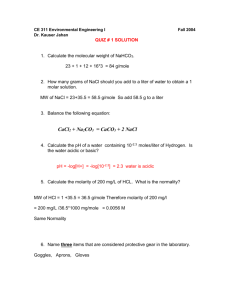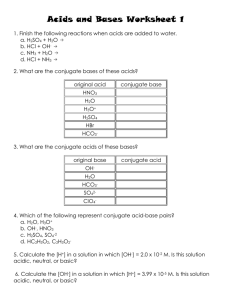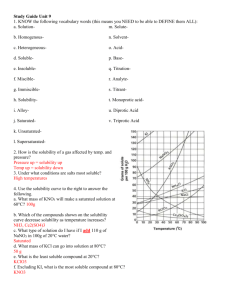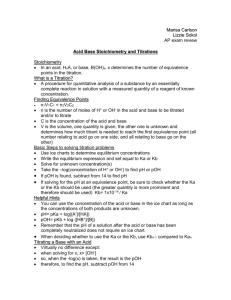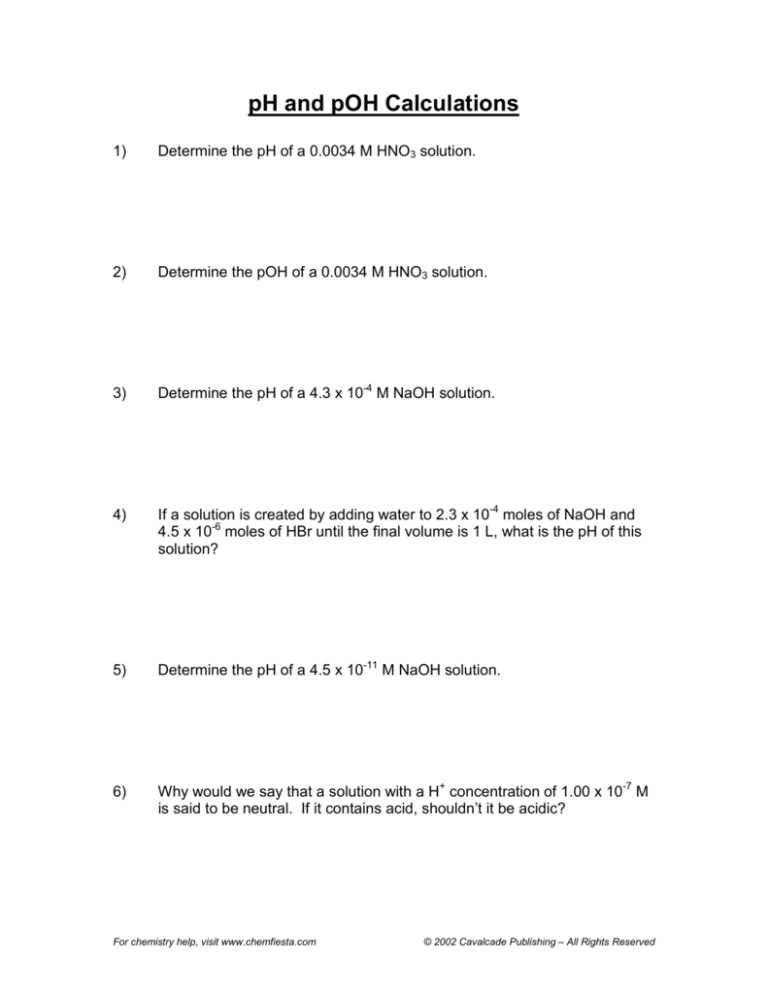
pH and pOH Calculations
1)
Determine the pH of a 0.0034 M HNO3 solution.
2)
Determine the pOH of a 0.0034 M HNO3 solution.
3)
Determine the pH of a 4.3 x 10-4 M NaOH solution.
4)
If a solution is created by adding water to 2.3 x 10-4 moles of NaOH and
4.5 x 10-6 moles of HBr until the final volume is 1 L, what is the pH of this
solution?
5)
Determine the pH of a 4.5 x 10-11 M NaOH solution.
6)
Why would we say that a solution with a H+ concentration of 1.00 x 10-7 M
is said to be neutral. If it contains acid, shouldn’t it be acidic?
For chemistry help, visit www.chemfiesta.com
© 2002 Cavalcade Publishing – All Rights Reserved
pH and pOH Calculations - Answers
1)
Determine the pH of a 0.0034 M HNO3 solution.
pH = -log[H+] = -log(0.0034) = 2.47
2)
Determine the pOH of a 0.0034 M HNO3 solution.
pH = -log[H+] = -log(0.0034) = 2.47
pOH = 14 – pH = 14 – 2.47 = 11.53
3)
Determine the pH of a 4.3 x 10-4 M NaOH solution.
pOH = -log[OH-] = -log(4.3 x 10-4) = 3.37
pH = 14 – pOH = 14 – 3.37 = 10.63
4)
If a solution is created by adding water to 2.3 x 10-4 moles of NaOH and
4.5 x 10-6 moles of HBr until the final volume is 1 L, what is the pH of this
solution?
To solve:
• Both acid and base are present. Since they neutralize each other,
you must first figure out how much acid or base is left over after it
neutralizes. Since the amount of base is larger than the amount
of acid, there will be more base than acid. The amount of base is
2.3 x 10-4 – 4.5 x 10-6 = 2.26 x 10-4 moles.
• Since there is one L of solution, the molarity of the base is 2.26 x
10-4 M.
• To find pOH, take the –log of 2.26 x 10-4, which is 3.65.
• To find pH, subtract 3.65 from 14. The pH of this solution is 10.35.
5)
Determine the pH of a 4.5 x 10-11 M NaOH solution.
Although there is some NaOH present in the solution, the pH isn’t
found by taking the –log of anything. The reason for this is that the
concentration of base is much, much smaller than the concentration
of acid which is naturally found in neutral water. As a result, this
base doesn’t really have any affect on the pH, so the pH of the
solution is 7.00.
For chemistry help, visit www.chemfiesta.com
© 2002 Cavalcade Publishing – All Rights Reserved
6)
Why would we say that a solution with a H+ concentration of 1.00 x 10-7 M
is said to be neutral. If it contains acid, shouldn’t it be acidic?
It isn’t acidic because while there is some acid in the solution, there
is an equal quantity of base. In neutral solutions, the H+ and OHconcentrations are identical, because water breaks up to form them.
As a result, the solution is neither acidic nor basic.
For chemistry help, visit www.chemfiesta.com
© 2002 Cavalcade Publishing – All Rights Reserved

